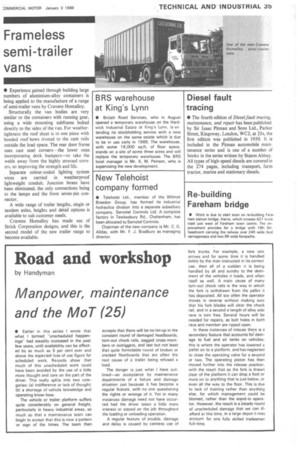Road and workshop
Page 37

If you've noticed an error in this article please click here to report it so we can fix it.
Manpower, maintenance and the MoT (25)
by Handyman
• Earlier in this series I wrote that what I termed "unscheduled happenings" had steadily increased in the past few years, until availability can be affected by as much as 5 per cent over and above the expected loss of use figure for scheduled work. Records show that much of this unscheduled work could have been avoided by the use of a little more thought and care on the part of the driver. This really splits into two categories: {a) indifference or lack of thought; (b) a shortage of vehicle knowledge and operating know-how.
The vehicle or trailer platform suffers quite considerably on general freight, particularly in heavy industrial areas, so much so that a maintenance team can begin to accept that this is now a pattern or sign of the times. The team then accepts that there will be no let-up in the constant round of damaged headboards, torn-out chock rails, sagged cross-members or outriggers, and last but not least that quite formidable round of broken or cracked floorboards that are often the root cause of a trailer being refused a. load.
The danger is just what I have outlined—an acceptance by maintenance departments of a failure and damage situation just because it has become a regular feature, with no one questioning the rights or wrongs of it. Yet in many instances damage need not have occurred had the driver taken a little more interest or stayed on the job throughout the loading or unloading operation.
A regular feature of trouble, damage and delay is caused by careless use of fork trucks. For example, a new one arrives and for some time it is handled solely by the man instructed in its correct use, then all of a sudden it is being handled by all and sundry to the detriment of the vehicles it loads, and often itself as well. A main cause of many torn-out chock rails is the way in which the fork is withdrawn from the pallet it has deposited. All too often the operator moves in reverse without making sure that his fork blades will clear the chock rail, and in a second a length of alloy side rave is torn free. Several hours will be needed for repairs, as bolt holes in both rave and member are ripped open.
In these instances of misuse there is a secondary feature that accounts for damage to fuel and air tanks on vehicles, this is where the operator has lowered a pallet on to a platform, and has neglected to close the operating valve for a second or two. The operating piston has then moved further into the release position, with the result that as the fork is drawn clear of the platform it can drop a foot or more on to anything that is just below, or even all the way to the floor. This is due to lack of training rather than anything else, for which management could be blamed, rather than the stand-in operator. However, the result is a steady round of unscheduled damage that we can illafford at this time, in a large depot it may account for one fully skilled tradesman full-time.




























































































